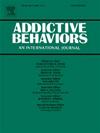E-cigarette use among a national sample of adults receiving substance use treatment in the United States
IF 3.7
2区 医学
Q1 PSYCHOLOGY, CLINICAL
引用次数: 0
Abstract
Background
Smoking among adults in substance use disorder (SUD) treatment programs is common with limited success in quitting. Given e-cigarettes’ potential for smoking harm reduction, it is important to examine e-cigarette use among people in SUD treatment.
Methods
We analyzed data from adults who have received SUD treatment in the past year, from the 2020–2021 National Survey on Drug Use and Health (N = 1,246). We delineated correlates of lifetime and current (past-month) use e-cigarette use.
Results
Among adults receiving SUD treatment, an estimated 39.4 % (95 % CI: 34.1, 45.1) have used e-cigarettes in their lifetime and 19.5 % (95 % CI: 16.1, 23.6) of those currently vape. Among those reporting current vaping, an estimated 57.3 % (95 % CI: 44.9–68.8) currently smoke cigarettes and half (54.2 % [95 % CI: 41.1–66.7]) currently use cannabis. Compared to those who only received treatment for alcohol use disorder, those receiving treatment for drug use (aPR = 1.47, 95 % CI: 1.09–1.99) and alcohol and drug use (aPR = 1.60, 95 % CI: 1.16–2.22) had higher prevalence of lifetime e-cigarette use, and those reporting treatment for drug use only (aPR = 2.60, 95 % CI: 1.52–4.46) and alcohol and drug use (aPR = 2.82, 95 % CI: 1.63–4.87) also had higher prevalence of current e-cigarette use.
Conclusions
The prevalence of e-cigarette use was higher among those in treatment for both drug or alcohol and drugs only than those receiving treatment for only alcohol use. Smoking harm reduction interventions can potentially include e-cigarette among those receiving drug treatment. There is also a need to address challenges of dual e-cigarette and cigarette use, as well as dual e-cigarette use with cannabis.
美国接受药物使用治疗的成年人中电子烟使用情况的全国抽样调查
在接受药物使用障碍(SUD)治疗的成年人中,吸烟很常见,但戒烟成功率有限。鉴于电子烟具有降低吸烟危害的潜力,在接受SUD治疗的人群中检查电子烟的使用情况非常重要。方法我们分析了来自2020-2021年全国药物使用与健康调查(N = 1246)的过去一年接受过SUD治疗的成年人的数据。我们描述了终生和当前(过去一个月)使用电子烟的相关性。结果在接受SUD治疗的成年人中,估计有39.4% (95% CI: 34.1, 45.1)在其一生中使用过电子烟,19.5% (95% CI: 16.1, 23.6)的人目前使用电子烟。在报告目前吸电子烟的人中,估计有57.3%(95%置信区间:44.9-68.8)目前吸烟,一半(54.2%[95%置信区间:41.1-66.7])目前使用大麻。与仅接受酒精使用障碍治疗的患者相比,接受药物使用治疗的患者(aPR = 1.47, 95% CI: 1.09-1.99)和酒精和药物使用治疗的患者(aPR = 1.60, 95% CI: 1.16-2.22)终生使用电子烟的患病率更高,而仅报告药物使用治疗的患者(aPR = 2.60, 95% CI: 1.52-4.46)和酒精和药物使用治疗的患者(aPR = 2.82, 95% CI: 1.63-4.87)当前使用电子烟的患病率也更高。结论同时接受药物或酒精和药物治疗的患者使用电子烟的比例高于仅接受酒精治疗的患者。减少吸烟危害的干预措施可能包括在接受药物治疗的人群中使用电子烟。还需要解决电子烟和香烟双重使用的挑战,以及电子烟和大麻双重使用的挑战。
本文章由计算机程序翻译,如有差异,请以英文原文为准。
求助全文
约1分钟内获得全文
求助全文
来源期刊

Addictive behaviors
医学-药物滥用
CiteScore
8.40
自引率
4.50%
发文量
283
审稿时长
46 days
期刊介绍:
Addictive Behaviors is an international peer-reviewed journal publishing high quality human research on addictive behaviors and disorders since 1975. The journal accepts submissions of full-length papers and short communications on substance-related addictions such as the abuse of alcohol, drugs and nicotine, and behavioral addictions involving gambling and technology. We primarily publish behavioral and psychosocial research but our articles span the fields of psychology, sociology, psychiatry, epidemiology, social policy, medicine, pharmacology and neuroscience. While theoretical orientations are diverse, the emphasis of the journal is primarily empirical. That is, sound experimental design combined with valid, reliable assessment and evaluation procedures are a requisite for acceptance. However, innovative and empirically oriented case studies that might encourage new lines of inquiry are accepted as well. Studies that clearly contribute to current knowledge of etiology, prevention, social policy or treatment are given priority. Scholarly commentaries on topical issues, systematic reviews, and mini reviews are encouraged. We especially welcome multimedia papers that incorporate video or audio components to better display methodology or findings.
Studies can also be submitted to Addictive Behaviors? companion title, the open access journal Addictive Behaviors Reports, which has a particular interest in ''non-traditional'', innovative and empirically-oriented research such as negative/null data papers, replication studies, case reports on novel treatments, and cross-cultural research.
 求助内容:
求助内容: 应助结果提醒方式:
应助结果提醒方式:


